The last month has been dominated by work with only a few full days off, hence the lack of logs.
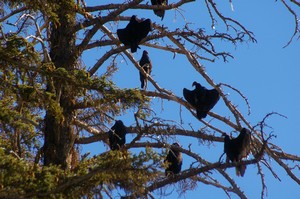 We’ve been travelling across the southern part of Colorado, with numerous stops along the way. Early morning, in the small town of Del Norte, we spy a tree full of Turkey Vultures, their wings spread, apparently sunning themselves. A little research, on our friend Google, reveals that UV kills the bacteria that builds up on their wings and beak due to their dining on meat that's not overly fresh.
We’ve been travelling across the southern part of Colorado, with numerous stops along the way. Early morning, in the small town of Del Norte, we spy a tree full of Turkey Vultures, their wings spread, apparently sunning themselves. A little research, on our friend Google, reveals that UV kills the bacteria that builds up on their wings and beak due to their dining on meat that's not overly fresh.
The same day we arrive at Highway Springs Campground and the hosts bring us half a Giant Puffball mushroom that they’ve just cut. I’ve never seen such a huge edible fungus and quickly consult the Google again, looking for tasty sounding recipes. For lunch, I coat slices in wheat germ and fry them in butter and olive oil - fantastic! I make a parmigiana for dinner, using the puffball instead of aubergine and the following night, use thick slices as a pizza base. Both recipes are a great success and will be repeated if we find one of these mushrooms ourselves. What a wonderful gift!
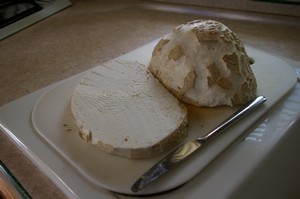
I’m less pleased with the ground squirrel that frequents our campsite. I’ve been trying to germinate some Joshua Tree seeds since we left their namesake park, earlier this year. My first effort was hopeless: no signs of greenery resulted from my tender care. My second attempt was much more successful with two proto trees slowly emerging. These seedlings had reached the impressive height of an inch and a half and I was feeling extremely pleased with myself. They need plenty of sunlight so when we arrive somewhere I have been putting the pot outside, this time on the picnic table.
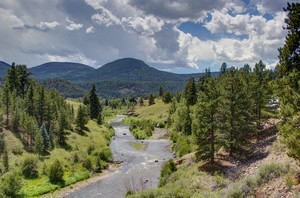 The squirrel in question looked cute enough and employed the usual disneyesque behaviour: standing on her back legs, batting her eyelids, climbing on my feet. However, the minute we were back in the camper, she was up on the table harvesting my seedlings. Looks aren’t everything!
The squirrel in question looked cute enough and employed the usual disneyesque behaviour: standing on her back legs, batting her eyelids, climbing on my feet. However, the minute we were back in the camper, she was up on the table harvesting my seedlings. Looks aren’t everything!
Not to be defeated I try a third time and am again rewarded by two seeds germinating. I’m not sure whether it’s too late in the year for success but am back in the business of watering them and putting the pot in the sunshine. A couple of weeks later, in a different campground, I again leave the pot on the picnic table and off we go on one of our rare days off. We return in the early evening to find that someone has taken our campsite, in spite of our tag still hanging on the post, and much more annoyingly has emptied the pot onto the ground. Something tells me it just wasn’t meant to happen although I’ve still got a few seeds and who knows, I might try again!
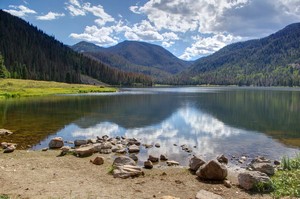 We move a few miles for a brief stop at Big Meadows Campground. It has been closed for the last three years as the Forest Service cleared the dead Lodgepole Pines that have been killed by an infestation of Mountain Pine Beetle and the associated fungus that is sweeping across much of the forested west. We heard moans from other campers that it had spoiled it, but clear open space is always good for our internet dish and solar panels, and it’s also fair to say that trees falling on people or RVs is probably less desirable than clearance.
We move a few miles for a brief stop at Big Meadows Campground. It has been closed for the last three years as the Forest Service cleared the dead Lodgepole Pines that have been killed by an infestation of Mountain Pine Beetle and the associated fungus that is sweeping across much of the forested west. We heard moans from other campers that it had spoiled it, but clear open space is always good for our internet dish and solar panels, and it’s also fair to say that trees falling on people or RVs is probably less desirable than clearance.
 Trees in the campground or not, it’s still a beautiful place. Big Meadows reservoir sits in a basin, the surrounding slopes mirrored in the water. A trail follows the shore and climbs up one of the feed valleys and we allow ourselves a couple of hours off the keyboards before we leave, heading for Pagosa Springs.
Trees in the campground or not, it’s still a beautiful place. Big Meadows reservoir sits in a basin, the surrounding slopes mirrored in the water. A trail follows the shore and climbs up one of the feed valleys and we allow ourselves a couple of hours off the keyboards before we leave, heading for Pagosa Springs.
We’ve stopped in far more towns than usual of late, motivated by our search for a future location to settle. The small mountain towns of southern Colorado all meet our basic requirements on paper but visiting a place often gives a very different feel. Pagosa has been high on our list for some time but after a visit gets relegated to the B list whilst a couple of weeks later, a visit to Durango weighted by few expectations, results in another town on the A list.
 We’re now heading towards an area rich in the archeological remains of the Ancestral Puebloan people who populated this area from about 550 CE to the late 1200s. Our first stop is at Chimney Rock National Monument, the site of an outlying settlement of the Chacoan culture. It’s an unusual part of the park system: it receives no federal funding and is operated by volunteers. Great House Pueblo is only accessible on a guided tour and sits on a fin of land, the end of which overlooks Chimney Rock and its Companion Rock. It has been proposed that the location is no mistake: at the Northern Major Lunar Standstill the moon rises between the two rocks.
We’re now heading towards an area rich in the archeological remains of the Ancestral Puebloan people who populated this area from about 550 CE to the late 1200s. Our first stop is at Chimney Rock National Monument, the site of an outlying settlement of the Chacoan culture. It’s an unusual part of the park system: it receives no federal funding and is operated by volunteers. Great House Pueblo is only accessible on a guided tour and sits on a fin of land, the end of which overlooks Chimney Rock and its Companion Rock. It has been proposed that the location is no mistake: at the Northern Major Lunar Standstill the moon rises between the two rocks.
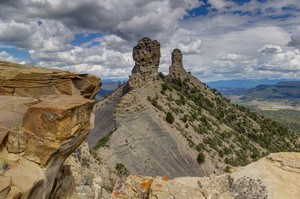 This phenomenon only occurs every 18.6 years and the theory and evidence suggests that the people who lived here revered the event and built the pueblo in order to observe it. Given that life expectancy was comparatively short, most people would only see this event once or twice in their lifetimes.
This phenomenon only occurs every 18.6 years and the theory and evidence suggests that the people who lived here revered the event and built the pueblo in order to observe it. Given that life expectancy was comparatively short, most people would only see this event once or twice in their lifetimes.
We stop close by the monument for a few days in a delightful campground at Lake Capote on the Southern Ute Tribe reservation. It’s quiet, cheap, well run and best of all, there are ospreys nesting.
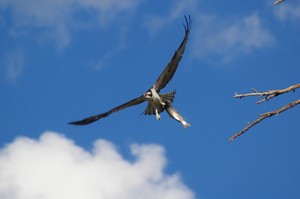 On several occasions we see the birds carrying their sizable prey up to a tree close to our campsite. The scavenging magpies turn up in short order, making their characteristic racket but careful not to get too close to the large talons and beak of the bigger bird. Sometimes the osprey settles down to lunch but other times it makes off with the fish intact, presumably returning to the nest to feed the young.
On several occasions we see the birds carrying their sizable prey up to a tree close to our campsite. The scavenging magpies turn up in short order, making their characteristic racket but careful not to get too close to the large talons and beak of the bigger bird. Sometimes the osprey settles down to lunch but other times it makes off with the fish intact, presumably returning to the nest to feed the young.
Perhaps the most famous of all Ancestral Puebloan locations is Mesa Verde National Park, a World Heritage Site, with over 5,000 ruins within its boundaries, 600 of which are cliff dwellings. Whilst the cliff dwellings are the main draw of the park, they represent a comparatively short period of habitation from about 1100 to when the people left less than a hundred years later.

In spite of the extensive remains, many crucial facts remain unknown and subject to theories and speculation. For me, the two most interesting questions are why the people moved from their homes on the mesa surface to the cliff dwellings and what prompted the mass exodus from the area.
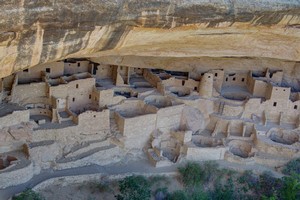 We take a couple of full days off whilst in the park the first of which is dominated by tours to Cliff Palace and Balcony House. The former is perhaps the most well known of Mesa Verde’s locations with one hundred and fifty rooms and twenty three kivas nestled in a large alcove in the sandstone cliff. The kivas are one of the interesting constructions: circular and subterranean it is speculated that they were used for both ceremonial purposes and also for general living in the winter months. Their use is thought to have been clan based and hence the number found in any given location. It is believed that the societies were matrilineal and it is interesting to speculate how the use and importance of kivas changed to their current day usage in modern pueblos as male only ceremonial areas.
We take a couple of full days off whilst in the park the first of which is dominated by tours to Cliff Palace and Balcony House. The former is perhaps the most well known of Mesa Verde’s locations with one hundred and fifty rooms and twenty three kivas nestled in a large alcove in the sandstone cliff. The kivas are one of the interesting constructions: circular and subterranean it is speculated that they were used for both ceremonial purposes and also for general living in the winter months. Their use is thought to have been clan based and hence the number found in any given location. It is believed that the societies were matrilineal and it is interesting to speculate how the use and importance of kivas changed to their current day usage in modern pueblos as male only ceremonial areas.
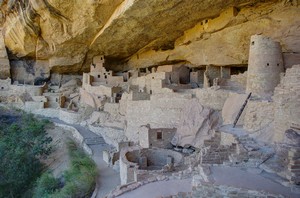
The original inhabitants came up and down from the mesa top without benefit of the metal staircases and steps hewn in the rock by the CCC. Todays exit from Cliff Palace might not be quite so exciting but the series of five ladders spanning a 30 meter/100 foot vertical climb up a narrow crevice still adds a little spice to the visit.
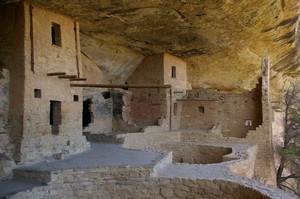 The adventure-o-meter registers on a whole different scale at our next tour: Balcony House. At the ticket selling counter in the visitor centre there is a mock ladder and crawl tunnel to help prospective visitors decide whether the tour is for them. Given my lack of balance and fear of heights, Sterling and I were discussing the pros and cons. As I mentioned our experience at Bandelier National Monument, the ranger interjected and assured me if I could do that, this would be a piece of cake.
The adventure-o-meter registers on a whole different scale at our next tour: Balcony House. At the ticket selling counter in the visitor centre there is a mock ladder and crawl tunnel to help prospective visitors decide whether the tour is for them. Given my lack of balance and fear of heights, Sterling and I were discussing the pros and cons. As I mentioned our experience at Bandelier National Monument, the ranger interjected and assured me if I could do that, this would be a piece of cake.
A wide, 32 foot/10 meter ladder stand between us and the ruin. People ascend two at a time, side by side. Sterling tells me that I set off quickly enough, motivated I suspect by my desire to get the experience over with as quickly as possible. The longer I’m on the ladder, the more my body and brain register what I’m up to and the fear surfaces. The trick is to stay very mentally focused on what I’m doing, not to look down and to keep moving: freezing is a real danger. Needless to say, I make it to the top and hear the ranger confidently assuring someone else that nobody has ever fallen: once on the ladder, the drive to survive is too strong, no one lets go. Reassuring!
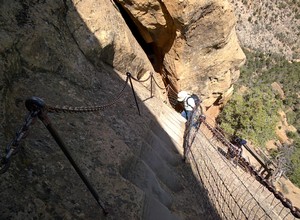
The exit is very nearly as exciting: a 12 foot/4 meter long tunnel is the next hurdle and crawling on hands and knees is the only way through the 18 inch/45 cm wide space that the original inhabitants created, presumably as a defence. The final challenge is the 20 meter/60 foot scramble back up the cliff face aided by ladders, stone steps and grab chains. Looking back down, I couldn’t quite believe I’d done it!
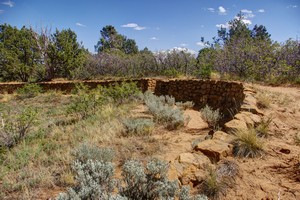 A couple of short walks on the mesa top round off the day. The first on Soda Canyon Overlook Trail gives us a view of Balcony House from across the canyon, the complexity of the construction clearly visible. The second is out the Farming Terrace Trail. The original inhabitants survived on a diet of cultivated corn, beans and squash, supplemented by hunting and gathering. This area of Colorado currently averages about 45 cm/18 inches of rain a year and from growth rings is assessed to be similar to the quantity at the time of the Ancestral Puebloans. To make the most of the challenging growing conditions, the farmers built retaining walls in south-facing draws creating small terraced areas for cultivation, and thus reducing soil erosion, slowing the rate of runoff and evaporation and increasing the soil temperature and hence extending the growing season. Water management was a significant achievement and remains of constructed reservoirs can still be seen in a number of locations on the mesa top.
A couple of short walks on the mesa top round off the day. The first on Soda Canyon Overlook Trail gives us a view of Balcony House from across the canyon, the complexity of the construction clearly visible. The second is out the Farming Terrace Trail. The original inhabitants survived on a diet of cultivated corn, beans and squash, supplemented by hunting and gathering. This area of Colorado currently averages about 45 cm/18 inches of rain a year and from growth rings is assessed to be similar to the quantity at the time of the Ancestral Puebloans. To make the most of the challenging growing conditions, the farmers built retaining walls in south-facing draws creating small terraced areas for cultivation, and thus reducing soil erosion, slowing the rate of runoff and evaporation and increasing the soil temperature and hence extending the growing season. Water management was a significant achievement and remains of constructed reservoirs can still be seen in a number of locations on the mesa top.
 Our second day off involves far less adrenaline. A paved path drops down to Spruce Tree House and we’re there early enough to beat the hoards and get some unpopulated photographs. It’s the third largest and best preserved cliff dwelling and the only one open to the public without a tour guide.
Our second day off involves far less adrenaline. A paved path drops down to Spruce Tree House and we’re there early enough to beat the hoards and get some unpopulated photographs. It’s the third largest and best preserved cliff dwelling and the only one open to the public without a tour guide.
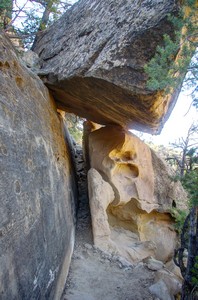 Using the very precise science of dendrochronology or tree-ring dating, the period of construction in the alcoves is known exactly: here at Spruce Tree House it was from 1200 to 1278 CE, a fairly short period for the amount of effort required to build these structures with stone tools.
Using the very precise science of dendrochronology or tree-ring dating, the period of construction in the alcoves is known exactly: here at Spruce Tree House it was from 1200 to 1278 CE, a fairly short period for the amount of effort required to build these structures with stone tools.
Leaving Spruce Tree House we set off on the Petroglyph Point Trail and amble at a very leisurely pace on this wonderful varied path. The outward section follows ledges along the cliff face, squeezing through narrow passes, following sections of steps laid or hewn by the CCC and offering a wonderful closeup look at the delightful shapes eroded in the sandstone. The petroglyph panel for which the trail is named is understood by modern day Hopi to represent the story of the people’s emergence from the earth and their migration from that point, various clans splitting off along the way. From the panel, the trail climbs back to the mesa top and from there, on the cliff top, back along the canyon.

Having seen a number of cliff dwellings we’re heading for one of the larger mesa top communities at Far View to visit five excavated dwelling sites and Mummy Lake, one of the reservoirs created by the early people.
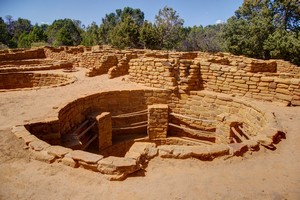 Coyote Village is perhaps the most interesting, partly because of the access allowed at the site. We wander through the village, peering down into the kivas, one of which has wooden beams between the upright pilasters thought perhaps to have been drying racks or shelves.
Coyote Village is perhaps the most interesting, partly because of the access allowed at the site. We wander through the village, peering down into the kivas, one of which has wooden beams between the upright pilasters thought perhaps to have been drying racks or shelves.
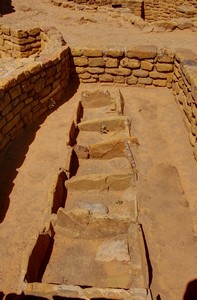 Elsewhere, the communal nature of life in the village is perhaps indicated by a row of mealing bins where the women knelt to grind corn using the traditional stones, mano and metate.
Elsewhere, the communal nature of life in the village is perhaps indicated by a row of mealing bins where the women knelt to grind corn using the traditional stones, mano and metate.
We came into Colorado back at the end of June and have had a really varied and enjoyable two months wandering around one of our favourite states. We’re a little sad to leave but this is offset by the fact that we’re going to Utah!